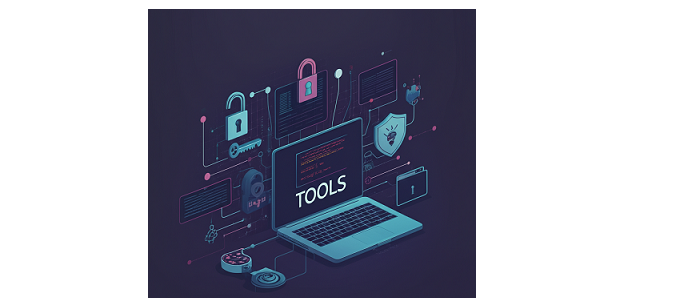Top 10 Penetration Testing Tools in 2025: Essential Tools for Ethical Hackers

In the ever-evolving world of cybersecurity, penetration testing remains a critical method for identifying and mitigating security vulnerabilities before attackers can exploit them. As we move into 2025, new threats have emerged, and so have more powerful tools to combat them. Whether you’re an ethical hacker, cybersecurity analyst, or IT professional, staying updated with the latest penetration testing tools is essential.
This article highlights the top 10 penetration testing tools in 2025 that are shaping the future of offensive security.
1. Metasploit Framework (Rapid7)
Still a king in the realm of penetration testing, Metasploit has evolved significantly in 2025. It remains the go-to framework for exploit development, payload delivery, and post-exploitation tasks.
Key Features:
- Huge library of exploits and payloads
- Integration with Nmap, Nessus, and Burp Suite
- Built-in scripting with Ruby
- Community and commercial editions available
Use Case: Exploiting known vulnerabilities and conducting simulated attacks in real environments.
2. Burp Suite Professional
Burp Suite by PortSwigger remains the most powerful web application penetration testing tool. Its 2025 release brings improved automated scanning, AI-assisted vulnerability detection, and enhanced reporting features.
Key Features:
- Intercept and modify HTTP/S requests in real-time
- Automated crawling and scanning of web apps
- Intruder module for brute force and fuzzing attacks
- Extensions support via BApp Store
Use Case: Web application testing, especially for OWASP Top 10 vulnerabilities like XSS, SQLi, and CSRF.
3. Nmap (Network Mapper)
Despite being one of the oldest tools, Nmap remains indispensable. In 2025, its newest version brings faster scanning capabilities and better support for IPv6 and IoT environments.
Key Features:
- Port scanning, service identification, OS fingerprinting
- Scriptable interaction with hosts using NSE (Nmap Scripting Engine)
- Visual network mapping via Zenmap
Use Case: Initial reconnaissance and network mapping before conducting active exploitation.
4. Nessus by Tenable
Nessus is one of the most trusted vulnerability scanners in the industry. Its 2025 update comes with machine learning-based threat classification and compliance-focused reporting.
Key Features:
- Scans for thousands of known vulnerabilities (CVEs)
- Custom policy creation and compliance checking
- Cloud and hybrid infrastructure support
- Integration with CI/CD pipelines
Use Case: Identifying and prioritizing system vulnerabilities before exploitation.
5. Wireshark
Wireshark remains the best-in-class network protocol analyzer. In 2025, it supports even more protocols, has enhanced decryption capabilities, and offers intuitive filtering.
Key Features:
- Real-time packet capture and deep inspection
- Custom display filters
- Exporting data for forensic analysis
- TLS decryption and VoIP analysis
Use Case: Passive analysis of traffic to detect anomalies, credentials, or exploit patterns.
6. OWASP ZAP (Zed Attack Proxy)
As an open-source competitor to Burp Suite, OWASP ZAP is ideal for developers and testers on a budget. In 2025, ZAP has improved its automation framework and headless testing support.
Key Features:
- Passive and active web vulnerability scanning
- API scanning and fuzzing
- CI/CD integration and Docker support
- Community-driven plugin ecosystem
Use Case: Automated web application security testing, especially for DevSecOps teams.
7. SQLmap
If you’re targeting SQL injection vulnerabilities, SQLmap is still the top choice in 2025. This open-source tool automates the process of detecting and exploiting SQL injection flaws.
Key Features:
- Database fingerprinting
- Automated database takeover
- Support for MySQL, PostgreSQL, MSSQL, Oracle, and more
- Bypasses WAFs and IDS systems
Use Case: Testing backend databases for SQL injection vulnerabilities in web apps.
8. BloodHound (with SharpHound)
BloodHound is essential for Active Directory enumeration. In 2025, it integrates better with hybrid AD environments and includes anomaly detection features.
Key Features:
- Visualize AD relationships and attack paths
- Custom queries using Neo4j
- Integration with PowerShell and C# collectors
- Post-compromise privilege escalation analysis
Use Case: Mapping attack paths in enterprise networks and identifying privilege escalation opportunities.
9. Kali Linux (Rolling Release 2025)
Not a single tool but a complete penetration testing distribution, Kali Linux includes hundreds of tools pre-installed, making it a staple for ethical hackers.
Key Tools Included:
- Metasploit, Burp Suite, John the Ripper, Hydra, Aircrack-ng
- Improved GUI interface (Xfce and GNOME options)
- Support for containers and ARM-based devices
Use Case: All-in-one platform for offensive security professionals.
10. Cobalt Strike (Advanced Adversary Simulation)
Used by red teams and threat actors alike, Cobalt Strike is a powerful post-exploitation and threat emulation platform. Its 2025 version includes expanded EDR evasion techniques and better team collaboration tools.
Key Features:
- Beacon payload for covert communication
- Customizable attack profiles
- Red team infrastructure automation
- Malleable C2 profiles for stealth operations
Use Case: Simulating advanced persistent threats (APTs) and training SOC teams.
Final Thoughts
The cybersecurity threat landscape in 2025 is more complex than ever, and having the right tools is essential for identifying vulnerabilities and strengthening defenses. Whether you’re conducting network penetration testing, web app assessments, or red team engagements, the tools listed above represent the best in class.
Stay sharp, stay updated, and most importantly, use these tools ethically and legally.
Bonus Tip: Choosing the Right Tool
No single tool fits every scenario. Here’s a quick comparison guide:
| Use Case | Recommended Tool(s) |
| Web Application Testing | Burp Suite, OWASP ZAP |
| Network Scanning | Nmap, Nessus |
| Post-Exploitation | Metasploit, Cobalt Strike |
| AD Enumeration | BloodHound |
| SQL Injection Testing | SQLmap |
| Wireless Attacks | Aircrack-ng (via Kali Linux) |
FAQ: Penetration Testing Tools in 2025
Q: Are these tools free?
A: Most tools like Metasploit, Nmap, SQLmap, and ZAP are open source. Tools like Burp Suite Pro, Nessus, and Cobalt Strike require a paid license.
Q: Can I use these tools on Windows?
A: Yes, though many are Linux-native, they can run on Windows via WSL or within a virtual machine.
Q: Are these tools legal to use?
A: Yes, only if used in authorized environments. Unauthorized testing is illegal and unethical.